studio 468
A working space in Rialto
Edited
by Logan Sisley and Siobhán Geoghegan
Published by studio 468 in collaboration with Common Ground, June 2010
The studio team wishes to thank the resident artists and all the individuals and organisations who have supported studio 468 over the years, including Jack Gilligan; Sinéad Connolly; Jimmy Fogart y; Liz Coman; Gerard Burke; Sheila McGuinness; Chris Maguire; The Board of The Rialto Development Association; Rialto Day Care Centre; Rialto Youth Project; Rialto Communit y Drug Team and all projects who have worked with the resident artists
studio 468 c/o Common Ground 15 Tyrconell Road, Inchicore Dublin 8, Ireland
T 01 454 8310 / 01 707 8766 F 01 454 8311
www commonground ie
Photography: Chris Maguire, Kieran Doyle O’Brien, Mirjam Keune, Enda O’Brien, Siobhán Geoghegan, Logan Sisley, and resident artists
Design: Atelier David Smith, Dublin Printing: Plus Print Limited, Dublin
© studio 468, the artists, and authors, 2010
ISBN 978 0 9539024 2 2

E n c o u n t e r i n g t h e Eve r yd ay
Siobhán Geoghegan 04 05
C o n t ex t u a l i s i n g t h e A r t i st : st u d i o 4 6 8 a n d t h e Re q u e st t o E n g a g e
Ailbhe Murphy 10 11
A r t , M e a n d C o m m u n i t e e
John Bissett 24 25
T h e A r t i st i n M e
Jamie Hendrick 34.35
A r t i st s i n Re s i d e n c e 48 49
Contents
E n c o u n t e r i n g t h e Eve r yd ay
Siobhán Geoghegan
On behalf of the studio 468 team
Since the mid 1990s Dublin Cit y ’ s urban landscape has altered fundamentally, shifting and re shaping how its citizens both physically and socially relate and exist alongside each other Not unlike New York in the 1970s, Dublin Cit y from the 1980s to mid 1990s housed a raft of ar tists in ‘low rental’ areas and neighbourhoods and warehouses alongside large public housing estates and traditional cit y communities 1 In many ways Rialto is an example of that juxtaposition, a pocket of ever yday life within a capital cit y Demographically it houses a ver y socially and economically mixed population with t wo large public housing schemes, the former Fatima Mansions and Dolphin House As an urban village, Rialto is sited2 behind the Guinness Brewer y (once the largest employer in the area) alongside the historical Liber ties and fifteen minutes walk away from the National College of Ar t and Design and the Irish Museum of Modern Ar t. Not surprisingly Rialto has attracted many ar tists over the years to live and work in the area.
Since the 1980s there has been a vibrancy and openness to engaging in the ar ts in the Rialto area through both amateur and professional initiatives either located in, or coming from, communit y and youth groups, individuals and drama groups based in St Andrew’s Communit y Centre on the South Circular Road The formation of studio 468 was in many ways a slow burn initiative but there is no getting away from the fact that its location in a vibrant and active communit y centre has influenced how both ar tists and local residents have contributed to the ways and means of encountering each other, which have been varied and vast
As a local resident you may have a longstanding relationship with a group based in St Andrew’s like Rialto Youth Project, where Jamie Hendrick continues to volunteer You or your family may have needed the ser vices of Rialto Communit y Drug Team or Rialto Day Care Centre, or perhaps you may have performed on St Andrew’s stage with Rialto Variet y Group, accessed the alternative therapies session held on a Saturday morning or par ticipated as a member of a local church group. Similarly you may have entered St Andrew’s for local politicians’ clinics, meals on wheels, bingo on a Friday night or as a voter in local, general or European elections You may have stumbled upon an ar tist based in, or out of studio 468 adding again to the differences and mix of daily life, all its encounters and realities Sometimes the ever yday in St Andrew’s and Rialto is a lot like Henri Lefebvre’s description:
04 05
Par ticipants in an invited ar tists’ discussion event, Februar y 2008 Left to right: Siobhán Geoghegan, Thomas O’Connor, Tony Fegan, Frances Mezzetti, Fiona Whelan

Something, we will say, which is not easy to dene, precisely since this something is not a thing, nor a precise activity with determined outlines. So what is it? A mixture of nature and culture, the historical and the lived, the individual and the social, the real and the unreal, a place of transitions, of meetings, interactions and conicts, in short a level of reality In one sense there is nothing more simple and more obvious than everyday life How do people live? The question may be difcult to answer but that does not make it any the less clear In another sense nothing could be more supercial: It is banality, triviality, repetitiveness And in yet another sense nothing could be more profound 1
While the establishment of studio 468 was a natural progression and response to those years of encountering the ar ts in Rialto during the 1980s and 1990s, how it came about as a local development initiative is impor tant to mark in this publication
During the 1990s Chris Maguire, a local resident and visual ar tist, became an active member of Rialto Development Association (RDA) and witnessed the diversit y of ar tists that came into the area during that time. As a practicing ar tist himself Chris was aware that there was a ver y real gap in Dublin of facilities for ar tists interested in developing their ar tistic practice in a neighbourhood setting which could provide the possibilit y of working in collaboration with local residents and/or communities of interest During this time Chris proposed to the RDA the possibilit y of developing a self sustaining ar tist’s studio that would be integrated and built in St Andrew’s On a couple of occasions the idea of the studio presented itself for possible development by the RDA but as an organisation it had many other more per tinent responsibilities in terms of managing and maintaining St Andrew’s prior to embarking on new buildings As a result the construction of the studio was postponed on at least t wo occasions
The end of the 1990s brought a different set of realities for studio 468 to be realised Thanks to the ‘ can do attitude’ and suppor t of Dublin Cit y Council’s ar ts officers Jack Gilligan and Sinéad Connolly, the establishment of Common Ground and the commitment of the RDA, a studio team was formed in 1999 to manage the development of studio 468 which is representative of Common Ground, the RDA and Dublin Cit y Council. In 2000 Common Ground secured IR£25,000 in capital funding towards studio 468’s construction which was pooled with the RDA’s Young Peoples Ser vices and Facilities award These funds were integrated with the construction costs of the new day care centre for the elderly in St Andrew’s
It has always been the studio team’s intention that studio 468 would offer extended and multiple ar tistic practice possibilities for ar tists and communit y to reflect on the contemporar y world in ways that may never have been imagined As it’s alternatively situated in a vibrant and active communit y centre, studio 468 acts in a different way to traditional ar tists’ studios, hosting multiple possibilities for ar tists and the immediate communit y to respond to their place and neighbourhood Impor tantly studio 468 offers ar tists time to initiate or develop work and since its first ar tist residency in December 2003 with Nevan Lahar t it has hosted thir teen ar tists including a selection of Irish and international visual ar tists, filmmakers, contemporar y dancers and classical musicians. For many ar tists this can be the shift from working and practicing in isolation to researching and making work with or in response to different communities of interest or ideas studio 468 is always interested in ar tists that describe and present differing views on contemporar y life and in its modest y represents an intimate par t of Dublin’s alternative ar tistic and ever yday life, constructing and growing a knowledge base that has extended beyond Rialto with residency applications from Ireland and beyond The diversit y of practices and
06 07
initiatives have lived beyond their residency time. These include Seoidín O’Sullivan initiating a permaculture practice and establishing a local communit y garden in a disused car park on the South Circular Road, Fiona Whelan’s practice with the What’s the Stor y? collective, Anne Maree Barr y ’ s Rialto Twirlers shor t film and Kang Hyun Ahn’s local performances on the streets of Rialto, Hello to all my new neighbours
When ar tists finish their residency in studio 468 the studio team asks ar tists what has their experience of working in the studio been like and have there been unexpected benefits or shifts for how they make or view their work? Ailbhe Murphy’s essay refers to this as ‘learning in public’ The challenge of engaging in the ar ts at all is described perfectly in John Bissett’s essay: ‘To go sideways a little bit and be prepared to not know or have an opinion A sor t of ‘willing’ to engage ’ The studio team is ver y proud that this publication marks the first eight years of studio 468’s existence and learning
It marks and honours the risks that have been taken by ar tists, individuals and groups alike to find meaningful and diverse ways to work together. The studio team hopes that studio 468 inspires others to take similar risks to create their own ar ts and cultural spaces, be they local residents, ar tists or organisations. SG 04 2010
1 Dublin Cit y s urban planning strategy from the mid 1990s to the late 2000s can be described as aiming to shift the demographic statistics that had for years identied pockets of endemic povert y, public housing populations and lone parents, particularly in the inner cit y of Dublin It is no surprise that at the same time artists and their inner cit y neighbours made way for large scale private housing and commercial developments through large scale reallocation of private propert y and public land, through the sale of public land through largely public private partnerships For more information see Bissett, J , 2009 Regeneration: Public Good or Private Profit? Dublin: Tasc/New Island; or Drudy, P J , http://www tcd ie/Economics/staff/p j drudy htm
2 Rialto is an urban village located in the south west inner cit y of Dublin For many years it housed two large public housing complexes, the former Fatima Mansions and Dolphin House whose demographics highlight long term endemic social and economic factors: high unemployment, high opiate drug use, early school leaving and lone parenting The demographics also describe a large elderly population and increasing social gentrication with a new urban professional class moving into the area
3 Lefebvre H 1961 Clearing the Ground In: Johnstone S ed The Ever yday London: Whitechapel Galler y and MIT Press 2008 33
4 studio 468 is managed by a studio team whose members are: Siobhán Geoghegan, Director of Artistic Programme, Common Ground, a local arts development organisation, Sheena Barrett, South Central Area Arts Ofcer for Dublin Cit y Council, Chris Maguire, a local artist and Director of Rialto Development Association (RDA) and Kieran Doyle O’Brien, local artist The studio team meets ever y six weeks In 2007 Logan Sisley was appointed on a contractual basis to assist with the management and development of the studio Common Ground is a local arts development organisation and registered
charit y Established in 1999 it is committed to creating opportunities for professional artists and communities to engage with each other in a variet y of ways Through the role of its Director of Artistic Programme, Common Ground actively supports the artists residencies and studio 468 s development and commits approx €10,000 annually to fund artists stipends and the studios general upkeep and maintenance For Common Ground, studio 468’s development is part of an ongoing commitment to support sites for emerging artists who seek to practise in a socially engaged or contextual practice It offers a space for contemporar y art practices that test and take risks to emerge, often beyond the residency timeframe and continuing to nd ways to challenge and respond to the locale www commonground ie Dublin Cit y Council Arts Ofce provides a cit ywide arts development ser vice, from its base in The LAB on Foley Street The LAB also houses a contemporar y art galler y (primarily showcasing emerging artists), rehearsal studios for the performing arts and training room facilities for professional development Artist studios, exhibition and workshop spaces are also provided in The Red Stables, in St Anne’s Park The Arts Ofce Ser vice includes programmes for Older Persons Children and Young People strengthening participation and involvement of Dublin people in communit y festivals and arts initiatives and nancial support for arts organisations and artists working and living in Dublin Cit y Dublin Cit y Council Arts Ofce contributes to the ongoing development of studio 468 through a representative Arts Ofcer, Sheena Barrett Rialto Development Association (RDA) is based at St Andrew s Communit y Centre, Rialto Through supporting the development of studio 468 it offers the communities of Rialto opportunities to engage with a wide range of professional artists The RDA is the agency with ultimate responsibilit y for a number of critical communit y projects based in St Andrew’s including Rialto Communit y Drug Team, Rialto Day Care Centre for the Elderly and Rialto Youth Project The RDA gained funding through the Young Peoples Ser vices and Facilities Fund in 1999 to contribute to studio 468’s construction The RDA is a registered charit y
 Image from Kang Hyun Ahn, Do Focail, Mo Capall (Your Words, My Horse), video documentation of performance, 2006
Image from Kang Hyun Ahn, Do Focail, Mo Capall (Your Words, My Horse), video documentation of performance, 2006
10 11
C o n t ex t u a l i s i n g t h e A r t i st : st u d i o 4 6 8 a n d t h e Re q u e st t o E n g a g e
Ailbhe Murphy
What’s he building in there? What the hell is he building In there?
He has subscriptions to those Magazines He never waves when he goes by He’s hiding something from the rest of us He’s all to himself I think I know why
The main characteristic of the external gaze into a private creative space which Tom Waits evokes here is one of misgiving at the sense of purposefulness attaching to a dubious project behind closed doors However, the gaze from inside such private creative spaces out towards the world can also be somewhat circumspect In this essay I would like to explore that intersection bet ween the public gaze into the space of the ar tist’s studio and the individual gaze returned out into the space of the public I’d like to consider studio 468 and Rialto as a par ticular set of creative conditions which can animate the possibilities for some familiar misgivings and uncer tain encounters and at the same time as a place with the potential to reach new understandings for shared creative practice Let me begin by mapping some uncer tainties within the field of cultural production and the figure of the ar tist within it
Cultural Dividers
Those who work in the creative sphere or what is sometimes termed the field of cultural production must become accustomed to various forms of splitting. As a field of practice it appears to offer a cer tain set of choices presented as mutually exclusive destinations Within the moral economy of cultural practice the ar tist is confronted with the choice bet ween an uncompromising, singular ar tistic vision and commercial success It is no doubt a familiar moral corrective, as though a self conscious eye to the market will contaminate the aesthetic integrit y of the work By extension, there is
Tom Waits What’s He Building? from Mule Variations 1999
the perceived tension bet ween commercial success and critical acclaim, as though economic capital has some way of cancelling out cultural capital.
There is of course another almost defining dichotomy organised around the availabilit y of time for cultural production Perhaps the most compelling illustration of this long standing trade off bet ween time and sur vival is the iconic image of the lone ar tist in their studio with all the time in the world, pitted against the voracious teaching schedules of the ar t college In any case, there are innumerable other splits and sub splits around which the dilemmas of cultural practice can be understood as a series of somewhat dislocating choices Wrestling with these apparent dilemmas is one of the main preoccupations of those who are tr ying to ride the wave of cultural production and gain some stable position within it For those who have already managed to find some accommodation within this moral economy, in recent times yet another one of those binar y choices has been coming ever more clearly into focus It would not be accurate to say that this more recent one is new, it is perhaps better to say that it has always been there but is now beginning to find its own forms of institutional expression.1
So what is the shape of this new conceptual, moral and pragmatic fork in the road? Well it has something to do with the request for social engagement We are increasingly seeing forms of practice which have been identified (or self identify) as socially engaged, as ar t in context, as communit y based, as par ticipator y, as collaborative and so on This connective impulse is being increasingly interrogated within the discourse and practice of ar t and organized and disciplined within the institutional field of ar ts practice and within the ar t academy And yet the terms of reference for this request (and in some cases the demand) for social engagement have yet to be clearly formulated This conceptual and terminological confusion is borne out by the sheer constellation of potential approaches to engaged practice The diversit y of these approaches is reflected in their attendant frameworks of legitimisation which include relational aesthetics, new genre public ar t, activist ar t, connective aesthetics and dialogical practice among others. The emergence of an invitation to ar tists such as that extended by studio 468 should be understood in the context of this gathering of momentum at the level of institutional arrangements within an evolving field of practice
Contextualising the Ar tist
studio 468 is located in St Andrew’s Communit y Centre in Rialto, an urban village in Dublin’s southwest inner cit y St Andrew’s is an impressive building Formerly a church and school, it is now home to a number of communit y development organisations which together provide a range of facilities and programmes for residents in the Rialto area The impetus for studio provision in Rialto came from the Rialto Development Association which owns and manages the St Andrew’s Communit y Centre studio 468 opened there in December 2003 The residency programme is managed and run by the studio 468 team which includes representation from the Rialto Development Association, Dublin Cit y Council and a locally based ar ts development organisation called Common Ground. Each of those par tners recognises the creative possibilities generated by having ar tists based in a communit y context More par ticularly, they recognise the potential for introducing ar tists to the specific context of the Rialto communit y which, over the past number of years, has seen the development of a rich variet y of ar ts and cultural practice
From the outset the studio 468 team has structured its invitations to ar tists in a
way that can combine the experience of an autonomous studio residency with the experience of direct engagement with the Rialto communit y. This has been achieved through a request that resident ar tists would collaborate with one of the youth and communit y development organisations or voluntar y groups based at St Andrew’s or in the wider Rialto area In this way studio 468 provides dedicated studio space for practicing ar tists and in turn, the engagement of those resident ar tists with a local organisation This t wo way exchange has been encouraged and formalised through gaining the commitment of the visiting ar tist to engage with an organisation for a period of six hours a week Ar tists choose the organisation they wish to work with Each ar tist is suppor ted in establishing those connections by Common Ground, the studio 468 team and through the suppor t of a par t time studio administrator In this way studio 468 seeks to contribute to the professional development of the resident ar tists, to the communit y organisations which the ar tists choose to work with and to the wider cultural life of the Rialto communit y.
Cultural Practice in Rialto
Ar tists arriving into the life of the communit y in Rialto via studio 468 are entering into an already vibrant fabric of ar tistic and cultural possibilities St Andrew’s Communit y Centre is home to a range of developmental and cultural initiatives The Rialto Youth Project has engaged in creative processes since it was established in 1981 In 2005 it became the first youth project in Ireland to engage a visual ar tist as one of their team In the last number of years, they have initiated international ar tistic exchanges, engaged in mural making at a local and international level, delivered performative events in public space and explored young people’s experiences through filmmaking and drama 2 More recently the What’s the Stor y? Collective, which is made up of six young adults, t wo youth workers and an ar tist presented a compelling collective stor ytelling performance event which was based on young people’s stories, all of which addressed the question of power.3
The Rialto Communit y Drug Team, also based in St Andrew’s, is a key member of the Canal Communities Local Drugs Task Force. Bet ween 2005 and 2008 the communit y representatives on the Task Force engaged in an exploration through the visual ar ts of their views and experiences of the drugs issue in the Canal Communities area The project culminated in a series of mixed media works which made up the Awakenings exhibition This exhibition was later complimented by a film which documented the making of the work and the contributions of those communit y representatives who were involved The Awakenings project has ser ved as a catalyst for debate and discussion among ar tists and communit y development practitioners in relation to the drugs issue at a cit y wide level
In the neighbouring Dolphin House flat complex, the Dolphin House Homework Club’s par ticipation in Common Ground’s Music for Me programme is now moving into its fifth year Music for Me is a Canal Communities wide programme which was piloted in both the Dolphin and Fatima Homework Clubs. Children bet ween the ages of six and t welve years of age come together at regular inter vals to play and perform a broad range of percussive and musical instruments facilitated by a range of professional musicians Their work has culminated in public performances held locally and in the Rotunda Room of Dublin Cit y Hall, the Shaw Room of the National Galler y of Ireland and the John Field Room of the National Concer t Hall
The Rialto Variet y Club is an amateur drama group represented within the Rialto Development Association Each year they engage a professional theatre director to
12 13
facilitate them to produce a pantomime in winter and a play in summer both of which involve a number of young people from the area.
Based on Reuben Street, Fatima Groups United is the umbrella communit y organisation for a number of local agencies Fatima Groups United has become synonymous with the production of large scale street spectacle and communit y based carnival That capacit y for large scale street spectacle was vividly demonstrated in October 2008 when Fatima Groups United, collaborating with Macnas and a range of visual and performing ar tists took a leading role in devising and producing a communit y wide Hallowe’en parade, The Night of the Dark Angel A number of locally based youth and communit y development organisations par ticipated in this event which involved 450 people of all ages The Night of the Dark Angel was the first of a proposed three year cycle of communit y based events to take place at Hallowe’en
The Ark, a children’s cultural centre in Temple Bar, conducted an outreach programme called ArkLink for over five years in Fatima Mansions. The Fatima Film Club is an extension of that programme. Its young filmmakers, aged bet ween nine and four teen years, have made a series of films which draw on young people’s experiences in the Rialto area The Fatima Film Club has won a number of national and international film awards
The examples mentioned here are highlighted by way of illustrating that studio 468 is par t of an already existing matrix of cultural endeavour within the Rialto area Far from a culturally blank canvas on which to inscribe the mark of creativit y, the studio 468 residency extends an invitation to ar tists to locate themselves within this wider nexus of communit y cultural development
studio 468 and the Request to Engage
I believe that it is the embedded nature of studio 468 which lends it a unique potential for contextualising ar tistic practice. And perhaps this is where the studio 468 team has been prescient in responding to the range of self splitting effects which are increasingly being felt and at times ar ticulated in the field of practice. How and when one propels oneself for ward as a potential collaborator is always critical As ar tists are increasingly negotiating their presence across a range of different contexts, they are also learning how to develop their ar tistic processes in a variet y of cross sectoral and inter institutional relations Negotiation is at the hear t of this work In the context of studio 468 an interesting challenge emerges Those inter institutional negotiations must be entered into and realised over a relatively shor t timeframe, usually six months The resident ar tists have responded in diverse ways to this challenge They have engaged with the potential for cross fer tilisation bet ween contemporar y ar ts practice and communit y in its broadest sense and with youth and communit y development practice more par ticularly Contemporar y concerns with situated practice, contextual work and notions of place have also been reflected in the ar tist residencies to date.
It is beyond the scope of this essay to make any comprehensive account of the diversit y and scope of the work of ar tists at studio 468 since the inception of the residency programme in 2003 At the same time it is possible to indicate, however telegraphically, something of the diversit y of forms of expression and the range of communit y experience represented Among the public manifestations of ar tistic engagement with the communit y there have been documentar y films, the creation of a communit y food garden, public musical performances, critical dialogue on the nature
of collaborative practice, dance on and off the street, the construction of informal net works, street performance and drama. The range of communit y experience animated by those creative engagements has been considerable. Without attempting any exhaustive catalogue it has included older people’s experience of social and recreational routines at their care centre, inter cultural experiences of place, the young dance communit y of Rialto, children’s experience via work with the homework clubs, women ’ s experience of cultural production and class, young men ’ s experience of the regeneration of their area and communit y response to the issue of drugs
At a time when studio space is so hard to come by in the cit y the resident ar tists have enjoyed access to a dedicated and well resourced working space 4 While based in studio 468 they also navigated, to different degrees, a tension which operates in that negotiation bet ween the individual and the collaborative domain of practice activated within the arena of contextual practice In relation to the individual domain of practice, there is almost an embodied sense of the studio as a necessar y space in which to work and develop ideas. It is a space for reflection and experimentation, where in the making of work it is possible to relinquish unsuccessful strategies and tr y out different avenues. To put it more succinctly, a studio is a space where things are allowed to go wrong as par t of the creative process For the ar tist there is a delicate balance in maintaining that legitimate space for experimentation, what one might call ar tistic autonomy in the midst of equally legitimate communit y and organisational expectations which the studio 468 request to engage necessarily entails
In the negotiation bet ween the individual and the collaborative domain of practice this delicate balance is played out on at least t wo levels Firstly, it is played out at the level of the contradiction bet ween the need to engage in speculation and experimentation as conditions of creativit y and on the other hand the requirement to present oneself within a specific communit y context as a creatively purposeful individual with a coherent, but not entirely pre determined plan of some kind Secondly, it is played out at the level of a sor t of moral tension bet ween an apparently ‘socially unengaged’ studio practice (evoked by the rather self absorbed protagonist in the Tom Waits song) and the seemingly more ‘civically generous ’ creative and social investments within the world of ar t in context studio 468’s explicit structuring of a cer tain distribution of labour bet ween studio based practice and communit y engagement has undoubtedly encouraged the diversit y of creative exchanges and the different strategies reflected in the approaches of the resident ar tists The residencies to date have reflected a number of key ar tistic and social concerns in the evolving field of engaged practice In this way, the studio 468 team has demonstrated a cer tain curatorial courage in making explicit the request to engage by formalising it as a defining characteristic of the residency experience
Learning in Public
In the broader landscape of studio provision in the cit y studio 468 inhabits a unique position as an interface bet ween ar tists and communit y. At this juncture six years on it may be timely to ask how studio 468 might continue to develop as a locus for exploring a number of central preoccupations within the contemporar y field of engaged practice Given the potential of studio 468 to develop those lines of inquir y fur ther, what might drive the evolution of the invitation to engage at studio 468? What if studio 468 was to amplify its potential to ser ve as a conduit bet ween ar tists and communit y? How could the studio 468 residency encourage an even greater proximit y bet ween the ar tist and the arena of cultural production that
14 15
surrounds them in Rialto? studio 468 has offered valuable suppor t to a range of professional ar tists at different stages of their career. How could the existence of this dedicated studio space also nur ture the development of ar tists emerging from within the local nexus of communit y based cultural production? For example how might regular access to studio 468 as a space for ar tistic experimentation encourage the ar tistic confidences of communit y workers who are increasingly engaging as cultural practitioners in the Rialto area?
One direction we could imagine would be the possibilit y of constructing longer term engagements where creative alliances bet ween ar tists and the communit y might form in ways that could transcend the existing constraints and determining parameters of the residency programme It is also possible to imagine extending and developing the function of studio 468 as a friendly base for an orientation to collaborative work For example, emerging ar tists at both graduate and undergraduate level might join their counterpar ts in the youth and communit y development sector. In this way studio 468 could be identified and known for providing an introductor y hub as well as an established base for engaged practice. The studio 468 residency is a place where those that have cast a public gaze inwards and those that have returned a private gaze out wards have met and looked each other directly in the eye What now are the conditions for dissolving some of the remaining misgivings and uncer tainties?
Ar tist and writer Claire Pentacost has described the ar tist as one who ser ves as a conduit bet ween specialised knowledge fields and other members of the public sphere She characterises this role for the ar tist as Public Amateur In this way she identifies them as: ‘ the person who consents to learn in public ’5 studio 468 could set out to create the conditions where the spirit of the studio as a site of ar tistic experimentation is understood by ar tists and others from specialised knowledge fields within the communit y These could include communit y representatives on a local drugs task force, youth workers, communit y development practitioners and those other members of the public drawn from the Rialto area. studio 468 is situating itself as a space that suppor ts ar tistic and cultural practice which develops, ar ticulates and critically reflects the potential richness of the interface bet ween ar tist and communit y in many of its complex forms Building on this strength it could uniquely position itself as a place where ar tists and others come to share And where together, they consent to learn in public AM 07 2009
1 Maria Lind writing in ‘The Collaborative Turn’ references the curator Angelika Nollert who points out that the rst known group of artists working closely together was the Nazarenes in Rome in 1810 1830 Nollert makes the point that this t ype of collaboration as a conscious strategy became possible when the guilds disappeared and the idea of the artists as a romantic individual came to the fore She also instances the newly proliferating collaborations between artists and curators artists and artists artists and others as gaining momentum in the 1990s See Lind M 2007 The Collaborative Turn In: Billing J Lind M and Nilsson, L , eds Taking the Matter into Common Hands London: Black Dog Publishing, 15 29
2 In 2005 the Rialto Youth Project developed an arts and cultural plan called Finding a Voice Over a three year period from 2005 2008 Finding a Voice set out to create a new and sustainable model of arts provision which encompassed visual and performing art forms The Rialto Youth Project continues to develop signicant arts and cultural projects across all art forms as a means of engaging young people in a range of social, cultural and educational initiatives
3 The What’s the Stor y? Collective was formed in 2008 and emerged from the long term collaboration between visual artist Fiona Whelan and the Rialto Youth Project What’s the Stor y? Collective is an interdisciplinar y group which sets out to explore the question of power both for the individual and in societ y through a range of projects and events See www section8 ie
4 In recent years with the increase in the value of cit y centre propert y independent studio space for artists has become increasingly difcult to establish and maintain in Dublin In 2008 the Arts Council appointed CHL Consulting Company, working with independent media and arts practitioners, to conduct a Review of Visual Artists Workspaces examining the provision of visual artists workspaces throughout Ireland The ndings of the review, published in March 2009, will assist the Arts Council in the development of its policy with regard to workspace provision
5 See Pentacost, C , 2008 Beyond Face In: Chodos, E , ed Talking With Your Mouth Full: New Language for Socially Engaged Art Chicago: Green Lantern, 29 45
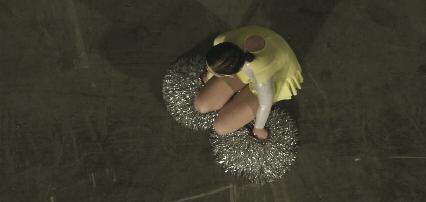


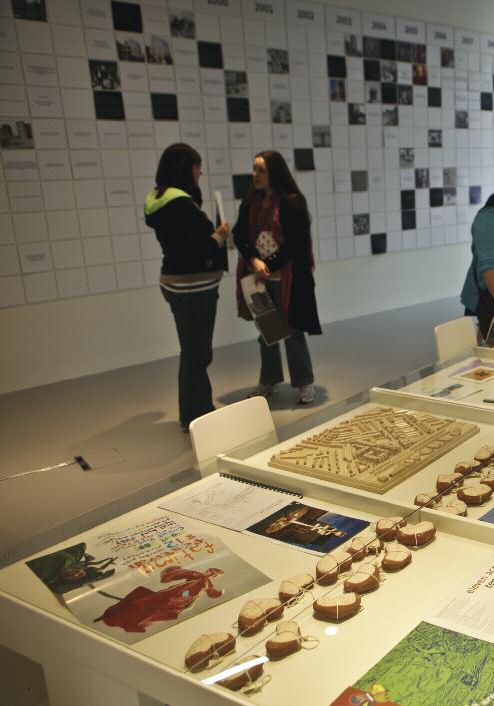

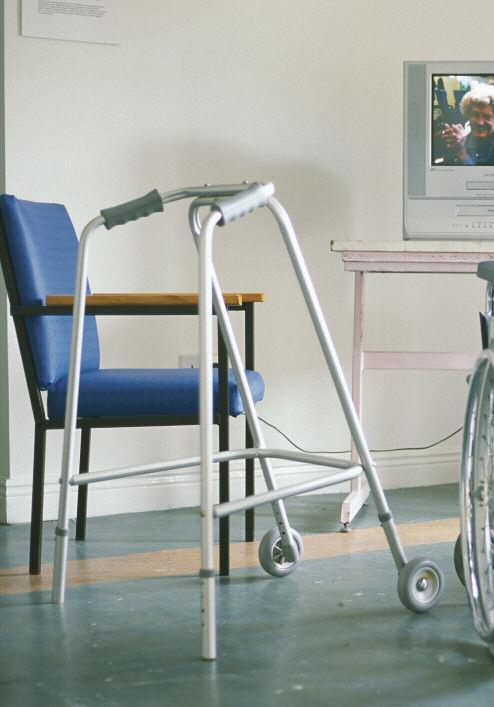
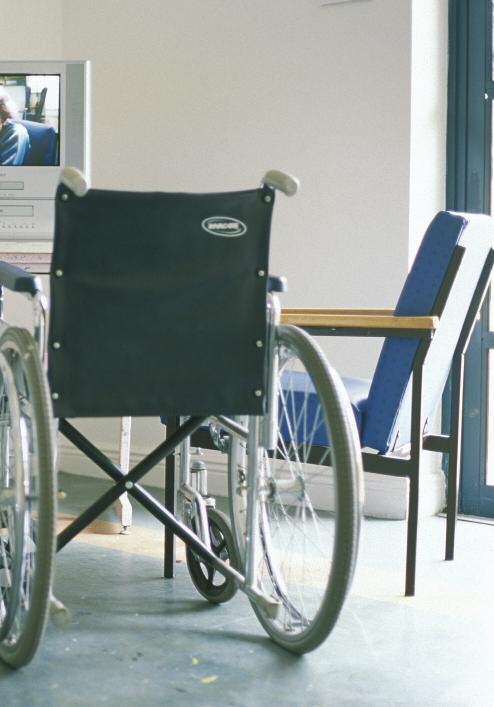


Full colour plates (previous pages): Page 17: Film stills, Rialto Twirlers, 2010, directed by Anne Maree Barry, featuring Kim Donahue, Lee Graham, Tara Kiernan, Sarah McCoy and Shelley Sheridan Pages 18/19: Vagabond Reviews and Fatima Groups United exhibition, Fatima A Cultural Archaeology, at NCAD Gallery, May 2009 Pages 20/21: View of an installation by Chris Reid at the studio 468 exhibition, July 2005 Pages 22/23: Jennie Moran, A Corner of the World, 2010 This page: Megan Kennedy
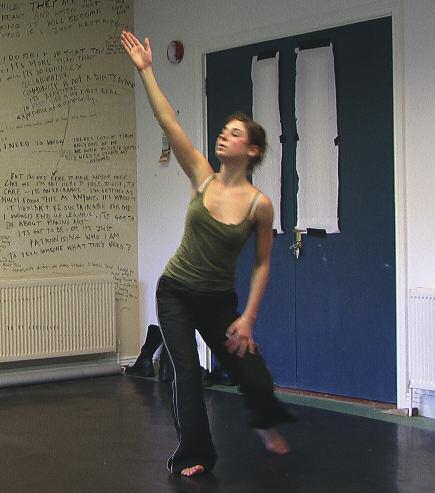
A r t , M e a n d C o m m u n i t e e
John Bissett
I must Create a System or be enslav’d by another man ’ s
I will not Reason and Compare: my business is to Create
William Blake, Jerusalem: The Emanation of the Giant Albion, c 1820
I tend to think of ar t as the opposite of work It involves work of course, spending time doing something but not at the instruction and timetable of someone else Ar t is something that you like to do, and that gives you energy and purpose and perhaps hope in a general sense. But I am a relatively recent conver t in many ways and I am struggling to find the place where ‘ ar t’ fits in my own life and in the work that I do. As I have had no formal ar tistic background or training I have no ar tistic boundaries as to what constitutes ar t and what does not Perhaps the first thing to say is that we, or most of us, have to work to live, therefore we have to build our lives around our own and our families’ material sur vival The nature of the work we do is a critical question related to the qualit y of our lives If people were happy doing what they do the world would be a much better place But that is a difficult place to get to So the context we find ourselves in is impor tant What are the social conditions of our lives, and how do they affect our creativit y, our ar tisticness? The social conditions of my life are ver y par ticular I grew up in Dolphin House, a working class cit y council flat complex in the south inner cit y, went to school in James’ Street, ser ved an apprenticeship, spent some time in Australia and Canada and had a moment of illumination, an epiphany, that I should go back to school, and did as a mature student I was lucky to be able to return to education, principally because I hadn’t yet had children and some educational institutions such as St Patrick’s College, Maynooth, were ver y favourable to people who had such epiphanies relatively late in life. I was able to subver t the dominant, linear model of education that sees you go through a series of stages at specific ages This is a form of education which is built on competition and where, by and large, we are prepared for specific, class based roles in the workforce I was able to take a little step back, and to get a little bit of control back over my life and to start again as it were The conditions of one ’ s life then, have a critical influence, some things are in and
24 25
some things are out. Ar t wasn’t talked about or practised in our household, nor was the idea of making things or creating things par t of my schooling It wasn’t par t of our habitus or way of living When I have par ticipated in dedicated ar t projects I often struggle with guilt for taking the time And developing a passion for something or an interest takes time It has to come from somewhere Doing something that gives you a sense of fulfilment Why write, or draw, or paint? People have different motives Pleasure is one, so too is acceptance, respect or perhaps even admiration from others Emily Dickinson wrote poetr y all of her life but none of it was ever published until she was dead. Why did she write? Probably because she liked doing it, it helped her to make sense of the world around her and offered her some sor t of fulfilment We all live different lives and I have been thinking recently that perhaps mine would be better if I did one thing or followed one thread such as writing I have dabbled in writing on and off for years but I never thought that I could live for it or make a living from it I was reading Joseph O’Connor’s novel recently, Star of the Sea, and one of the protagonists says that ‘the hardest thing about writing is knowing what to write about ’ Perhaps the answer for any ar t form or project is that you just star t and see where it takes you. The nourishing of such capacities has been something that we haven’t been too good at in Ireland It has really been a case of you either have it or you don’t have it The world becomes divided bet ween those who create and those who consume, instead of having a world where we all create, even to some small extent
Other People’s Ar t
I watched a documentar y many years ago now by the Australian writer and ar t critic Rober t Hughes called The Shock of the New I hadn’t been taught the codes or the language for deciphering ar t but Hughes presented all of these different ar t forms and pieces with such enthusiasm and vigour that he sucked me in. I went out and bought the book of the series and I have picked up other strings in the sand since then and followed them to all sor ts of places I was amazed at the things that people did and the things they made, from paintings to buildings But the one thing that stayed with me
was that Hughes said good ar t has a resonance. That was his definition. I took it to mean that it left a mark on you or an inner vibration that continued to hum long after you turned off the T V or put the book down. I presume that it’s the same for making something One of the more offbeat and interesting pieces that Hughes introduced were the abstract paintings of the Lithuanian born American émigré ar tist Mark Rothko Hughes showed a series of Rothko’s paintings that hang in a chapel in the southern United States (Rothko himself called these paintings ‘colour fields’ ) There are also other huge paintings that hang in Tate Modern next to Southwark Bridge on London’s South Bank Rothko’s paintings are enigmatic and to some extent indecipherable but there is a myster y and a depth in them that makes one ask why did he do that and what was it all about? I still like them to this day And I think that one of the reasons I like them is because I don’t understand them I want to understand what they are about but perhaps if I did I would lose interest in them Rothko killed himself while working on his last painting, his death was his final ar t bequest to the world. I have come to understand that you have to step off the life train if you want to see or experience things like that. To go sideways a little bit and be prepared to not know or have an opinion. A sor t of ‘willing’ to engage. But there is quite a distance bet ween going to see the work of feted or celebrated ar tists like Rothko whose work still remains at the higher end of the cultural mainstream and beginning to think about making or doing a piece of ar t oneself or with a group It’s a difficult transition ‘Great ar t’ may inspire but it can also paralyse people into thinking that it’s the only real ar t
Ar t and Us
One of the things I have done in recent years has been to tr y and introduce ar t into the work that I do with a group of people I work with as a communit y worker All members of the group are connected to the Local Drugs Task Force1 and given the histor y of the past t went y years in this area, our theme for the project, perhaps unsurprisingly, was Ar t and Drug Use. We tried to look sideways at the drugs issue using various ar t forms. There were six of us, all working within the Rialto, Inchicore and Bluebell areas (collectively known as the canal communities). Besides working in various communit y projects, the one thing we had in common was the fact that we had never really ‘done’ ar t for or by ourselves before The basis for the project was that we would approach it as a group This approach was taken because I believed that none of us, without suppor t, would sustain an ar t piece from beginning to end as individuals And these were all highly motivated, dynamic individuals Ar t just wasn’t par t of our natural habitus or way of being
We were lucky enough to work with the worldwise Rialto ar tist Chris Maguire who ebbed and flowed ergonomically with our energy as a group over a t wo and a half year period Chris used to say that the only difference bet ween ar tists and non ar tists was the fact that ar tists act on their impulses and give time to them They do, whereas the rest of just watch those who do and think it’s not for us I took Chris’s point to mean that all of us can ‘do’ ar t, we just need to shunt our thinking over and be a little bit like Yosser Hughes and say ‘I can do that’. Looking back at it now, we were entering into the space of ‘ can I make something’ or ‘ can I really do that’? It was risky and unnatural for all of us But we persevered, perhaps the greatest qualit y you can have Be a dogged bastard and you can be an ar tist Just sit and wait and the inspiration will come We rarely let ourselves have the time But on this occasion we did It was slow and awkward, sometimes excruciating but we kept going We had ridiculous thoughts and ideas about what we could do We used paint, we used crayons, cameras, clay and
26 27
a host of other materials to see what we could make. We thought about the idea of making one big collective ar t work. At the ver y star t we tried to do this on large white sheets pinned to a wall, with people layering stuff on after each other We discovered we weren’t quite ready for that I had come across an exhibition of aboriginal paintings in the Carlow Institute of Technology on the way back from Tramore a few years ago and had thought that they embodied an almost perfect collective ar tistic process Their simplicit y, colour and scale was astonishing Some of the pieces were about t went y five feet by ten But they had had thousands of years to perfect their craft, we were just star ting. We looked at the work of other contemporar y European ar tists. The now infamous and subversive London ar tist Banksy was a topic of discussion for a while He prowls around London streets by night and leaves provocative, socially engaged murals and ar t pieces anywhere he can Two male London policemen, kissing each other while dressed in full uniform is one that sticks in the mind But his st yle and the forms he used were simple and accessible and provided the inspiration for a brilliant mural piece by Walter Bowden that eventually materialised and was painted on to the side of a small local power station in St Teresa’s Gardens. The making of the mural was filmed as it happened over the course of a full day. The mural developed over a period of many months gradually coming into being from fragments of ideas The same is true for a piece by Eilish Comeford, one of the women in the group She had grown up in rural Kilkenny and had come to work in St Michael’s Estate, Inchicore She used photography to illustrate her shock at coming to work in the estate for the first time The piece contrasted the claustrophobic nauseating interiors of the blocks with the panoramic breathtaking view over the cit y from the upper floors It was entitled That I may never get used to this The contrast bet ween the urban and rural and the harshness of the urban landscape was detailed in a written piece that accompanied the photographs.
Another of the women in the group, Cathy Thorpe, was interested in using the idea of a maze to express the myriad turns, re turns and detours that take place on the road into and out of problem drug use After creating a maze on a base
Below:
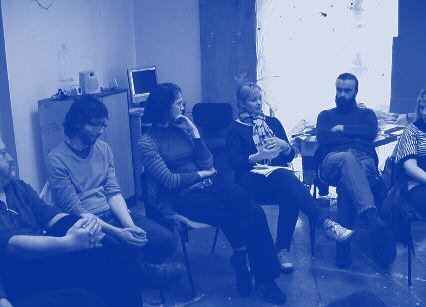
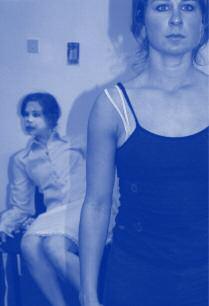 Right: junk ensemble (Megan Kennedy and Jessica Kennedy), Circus Freak
Par ticipants in an invited ar tists discus sion event, Februar y 2008 Left to right: Chris Reid, Dennis McNult y, Seoidín O Sullivan, Anne Maree Barr y, Terr y Blake, Lisa Marie Johnson
Right: junk ensemble (Megan Kennedy and Jessica Kennedy), Circus Freak
Par ticipants in an invited ar tists discus sion event, Februar y 2008 Left to right: Chris Reid, Dennis McNult y, Seoidín O Sullivan, Anne Maree Barr y, Terr y Blake, Lisa Marie Johnson
 Nevan Lahar t speaking to students from NCAD’s Postgraduate Diploma in Communit y Ar ts course
Nevan Lahar t speaking to students from NCAD’s Postgraduate Diploma in Communit y Ar ts course
of wood she made a collection of clay pieces and fitted them to the contours of the maze. The piece gradually unfolded over time with new pieces being added week after week until it became a finished work. Each piece had a reference point somewhere in the area either concretely or symbolically The pieces were hand painted and came to represent a communit y ’ s struggle with heroin and serious drug use over many years On the same theme but using a completely different form, a video piece by Tony May entitled Off the Wall captured an afternoon handball event under ‘The Arch’ in Fatima Mansions just weeks before the entire estate was demolished as par t of the regeneration of the complex This poignant shor t documentar y captured a communit y in transition with recollections from a male group of peers in their for ties and fifties about what it was like to grow up in the complex The brief conversational pieces in the film revealed a group of men who had led harsh lives and who had all lived through the heroin epidemic in Dublin from the late 1970s onwards They had sur vived, but at a price. The film touched the surface of the complexit y of serious drug use from pleasure to pain and ever ything in bet ween. It concluded with a roll call of those who had died from drug use over the years, played off against the sound of the ball popping off the wall under arch. An older brother of mine watched this film while it was on exhibition in Rialto and came out of the screening room in tears I think it touched something in him about his generation and growing up in the area and also about getting older
Another of the pieces that used film to convey its message was entitled Seven Drunken Nights Tommy Coombes had taken the old Dubliner’s ballad of Seven Drunken Nights and had reworked it giving the song a more contemporar y resonance to get at the underbelly of drug use, especially alcohol The film explored the dark side of our engagement with drug use, the damage it does to relationships and the abuse that sometimes results The film was made using a group of local actors from Dolphin House with each reciting a rewritten verse to camera The entire piece was shot in black and white and the camera just used the head shot giving the piece a ver y intimate and unsettling atmosphere. As each actor finished their piece they rotated and another replaced them. This shor t film touched a raw ner ve with people who saw it My own piece explored the relationship bet ween power, knowledge and drug use At the end of the 1970s and into the 1980s there was little formalised knowledge of drug use either from a quantitative or qualitative perspective in Ireland The one detailed account of drug use in Dublin in the 1980s was the book Smack which was more of a journalistic account of what happened But toward the end of the 1990s and with the establishment of Drugs Task Forces drug use has become something to be measured and to be quantified The ‘drug problem’ has become insitutionalised and colonised to an extent by the number crunchers and exper ts who hold cour t on its constitution and structure Experiential accounts of drug use tend to take second place and more and more the only ‘real knowledge’ is that which is produced by institutions such as the Health Research Board My piece contrasted these t wo sets of perspectives by using a four sided glass box onto which quantitative tables were printed while inside the box a sculpted human head represented the more experiential side of drug use.
Conclusion: Awakenings
All of these pieces together formed the Awakenings exhibition which went on display for a week across the three areas of Rialto, Inchicore and Bluebell in April 2008 The pieces were received fantastically well The impor tant thing was that we had tried to make ‘ ar t’ doable in an ordinar y sense Something that any of us could do with the
30 31
right suppor t and materials. Myself and Chris Maguire had acted as the ‘holders’ of the project, motivating people when their confidence was low or helping people to move from one stage to another. But perhaps the greatest strength was the group itself. Each valued the work of the other and encouraged it to continue All of us modified our expectations into something realisable as the project progressed Quite often the difficult piece was not generating ideas, there were loads of those, but getting from the idea to the thing itself Making the idea into something material and real The transition from idea to form What do you make it from, do I make a film, do I use a camera or clay? Finding a form that helps you to express the idea was difficult When we were about halfway through this process Chris used this huge accordion like picture book and presented all of the work to date on it The book was opened out on the floor and when we looked at it we were able to see where we had come from and where we were going Perhaps the one downside to the Awakenings project since it finished has been that almost all of those involved have gone back into their own specific jobs and have not, in my opinion, been able to sustain an ar tistic element within their work. I think there are a couple of reasons for this. The first of these is time. Creating time within hectic schedules is ver y difficult and almost all of the people in question have family lives to lead after a day’s work so it is difficult for them to get time there Many of them also work evenings The second problem is related to time and is one of legitimacy Many of us have been convinced that ar t is not a legitimate use of one ’ s time especially if you are being paid to carr y out a ver y specific job description Time is a problem as is the legitimacy of the activit y or the project You are paid to do cer tain sor t of work and do not stray I want to finish this essay with the stor y of a man who lived in Los Angeles and who, when he came home form work one day, decided that he would build a small sculpture out the back of his house using coloured bottles Like the beanstalk, the sculptures gradually became bigger and bigger and today have become a significant ar t tourist attraction in Los Angeles He had no formal ar tistic training, but what he did have was what William Blake was so adamant about, a desire to create. The trick for all of us is to find ways of acting on our ar tistic desires and make them catch fire. JB 11 2009
1 Local Drugs Task Forces were set up in Dublin and in Cork in the late 1990s to deal primarily with the opiate problem that was devastating working class communities and estates They have community, statutory and voluntary representation My job is to work with the community representatives on the Task Force and one of the key ways we have done this in recent years has been through the use of art
Ar t and me John Bissett
How did this Life of mine Come to be
The things I do The things I want The things I see
The world I know Does not much Exist in ar t
Excavate mind And memor y Dust off the par ts
Genealogy Histor y Sensibilit y
Work the raw materials With hand and hear t Set a universe free 10 2009
32 33
Jamie Hendrick
Beginnings
In 1998 when I was eight years of age I joined my first ar t group The group was known as the Mapping Group Through this group I learned about all the different t ypes of ar t When I was young painting, colouring and drawing was the only ar t I knew But through this group I learned how to make a 3D sculpture of my head using chicken mesh and clay I also made pieces of ar t out of plaster My favourite par t of the group was going to the Irish Museum of Modern Ar t (IMMA) ever y Wednesday I remember going into the museum, seeing all the ar t work and thinking ‘That’s just mad’, like the Ann Hamilton exhibition It was just hundreds of pieces of paper coming from the ceiling I remember having to dig for five minutes to finally see the ground I also remember the spinning cur tain and running in and out of it time after time after time until I was falling with dizziness. In 2002 the Mapping Group ended. At that time I never understood the meaning or the stor y behind the Ann Hamilton exhibition and still to this day I don’t I suppose when I was younger I just liked the look of it and if it did something cool I was sucked right in
In 2004 the ar tist Fiona Whelan took up her residency in studio 468 As par t of Fiona’s residency she chose to work with Rialto Youth Project So through the youth project and working with youth worker Irene O’Donahue, they both set up The Dolphin Ar t Group later known as D’Ar t Group I was a member of the group and all of a sudden I star ted to realise the meaning and the stor y of the ar t work I was working on The first project we did in 2004 was a 3D model of the Dolphin House flats where I live in Rialto We made the model by drawing a map onto a big piece of wood and then we star ted to slot in the blocks, the roads, the communit y centre, the old folks, the football pitch and the old rent office and many other main features of the flats
We added a bit of paint and completed our first ar t project as D’Ar t Group. We decided to make an exhibition of the work we had just completed and as it was coming up to Christmas we wanted to present Dolphin House as a Christmas Wonder Land. We put really small LED lights in the lamp posts of the model and had it wired up so that by the flick of a switch the model was lit up We presented the model in the communit y centre of Dolphin House and invited residents to come and see the model and talk about the future of Dolphin We revealed our model by turning on the LED lights and sprinkling snow all over it
T h e A
M
r t i st i n
e
34 35
Our next project in 2005 was to complete the first ever mural in Dolphin House. We discussed as a group what we wanted the theme of the mural to be and after a long in depth discussion we decided on the theme of ‘Dare to Dream’ We decided on this because some members of the group did not believe that their dreams could come true because of where they came from They felt people judged them because of where they came from, and other people in the group felt they could achieve any of their ambitions by just working hard and believing The image of the mural included a young person tr ying to reach for a dream bubble to accomplish his dream and another par t included t wo young people pushing back a wall to make room for them to accomplish their dreams by pushing back the barrier that stops them. We unveiled this mural at a big communit y festival in the Summer of 2005
America
We also did many small ar t projects in the group but our biggest project was travelling to America to paint a 200ft mural on to the side of a school In 2007 the group linked in with a group of young people in Philadelphia and the Philadelphia Mural Ar ts Programme Through a lot of e mails we created a mural which consisted of both the Irish and American groups ’ ideas. Then in 2007 D’ar t group travelled to America to paint our mural. We built a major relationship with the American group over the 10 days and we were sad to say good bye because we didn’t think we would see them again, but we were wrong!
Only a couple of months later we were working on a local summer festival and Jim Lawlor (the manager of Rialto Youth Project) pulled me and a couple of other group members aside and told us that we were invited back to America If I remember correctly I jumped out of the chair I was sitting in and hugged Jim, as did the rest of the group and I just screamed the place down. We were going back to America and I was living my dream for the second time.
So we went back to America and rebuilt our friendship with our American friends, finished painting the mural and also did some T V, Radio and Newspaper inter views I was ‘Almost Famous’ After being to America t wice we felt like it was
Top to bottom: Presentation by Anne Marie McGrane, Culture Night 2008; Jane Hughes performing in the Rialto Day Care Centre; Lisa Marie Johnson performing at Tulca 2008, Galway, with projected video of Sinead from Inchicore


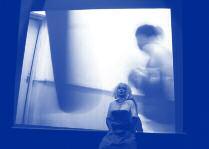
36 37
time for the Americans to come to visit us. During this time the group I had been par t of for almost five years was slowly but surely coming to an end. We remained together for the duration of the Americans visit to Rialto in the Summer of 2008 and we also invited a new group into the process The group was called the What’s the Stor y? group The D’Ar t group, the What’s the Stor y? group and the American group all worked together and star ted a discussion on the theme of ‘Power’
During that time we sourced over 50 Dublin Cit y Council sign posts and painted what we felt symbolised power onto them This project led to the star t of something brand new.
What’s the Stor y?
The D’Ar t group merged with the What’s the Stor y? group It was sad to see the D’Ar t group finish after almost five years of working together and building what was more than a relationship, it was a friendship, but I was excited about the road the new What’s the Stor y? group would take The What’s the Stor y? group consisted of one ar tist, t wo youth workers and eight young people The group was a rare kind of group, a power sharing group and the first group where I experienced the young people, youth workers and the ar tist all sharing the same amount of power. Power was always the main issue in the group from the ver y star t. At some stage I think almost ever yone in the group struggled about the realit y of sharing power while others were afraid to take their power This power struggle was, in my opinion at the time, holding the group back We spent most of the time arguing and others just couldn’t be in that space and just walked out and left I myself could not be myself in the group and wondered whether I could remain I really struggled with speaking out in the group because I felt it was not safe to speak out in After weeks of fighting and arguing and me saying nothing I finally took my power to speak out and tell other group members how I felt. Finally, after taking my power I felt like the group was at last going somewhere. Some people left the group after a while and in my opinion it was a good thing because I felt like that maybe they weren’t ready for that kind of a group Finally I felt comfor table and after this Rocky Road star t we did our first major project
Anonymous
We decided after all the power discussions that we would all tell stories of times we felt powerless. I don’t think anyone expected the project would turn out the way it did. Well I didn’t! The stories were so personal to the individual telling them So personal that we decided we did not want any one to know whose stor y was whose After a lot of emotional discussion we decided we wanted to put our stories out there to the public and at the same time we wanted our stories to remain anonymous We then created the first ever live reading event in Rialto called ‘Anonymous’ and we invited a select audience that we trusted These were youth workers, ar tists and young people who were from or worked in the Rialto area As par t of the event we also selected a number of ar tists, youth workers and young people to read our Anonymous stories aloud to the selected audience and our own What’s the Stor y? group At the end of the Anonymous readings we invited and received feedback from the audience The feedback caused a lot of emotion for the group and for the audience. Some of the audience felt like they wanted to tell their own personal stories and one audience member pointed out that a lot of the stories were to do with the Gardaí. Following the event we discussed this in the group and realised that a lot of the stories were actually to do with Gardaí, and that we had just selected and found our next audience for Anonymous
We then did some research and approached the Chief Superintendent of the South Dublin Cit y District of the Gardaí Straight away he was up for the project, but he wanted to know why we wanted to do it I suppose for me it was just for the Gardaí to hear my side of the stor y How I feel when they’re stopping me on the street or pulling me over or even when they’re kicking in my door I just wanted to scream into their face and ask ‘Why? Why did you do this? Why did you do that?’ But I needed to change my attitude if I wanted my answers We invited 24 trainee Gardaí, that had not been out on the beat yet, and t wo sergeants to an Anonymous event held in IMMA in July 2009. As a collective we felt we now held a powerful role as we planned and managed the event.
When the Gardaí entered the room they had to place their hats, Asp (baton) and hand cuffs on a table and took their seats We had a mixed bunch of witnesses with us, people of all backgrounds that we had invited separately to the Gardaí We invited thir teen Gardaí to read out the stories aloud and after the live reading we held a discussion session Some of the Gardaí felt like we were attacking them but some felt that we were ver y fair within our stories, one said ‘I am ashamed that Garda can do this to people ’ I was taken aback by this It was like I couldn’t believe how honest he was After the discussion ever yone went outside of the room for a cup of tea and for me it was the most memorable time of the event I had conversations with the Garda that I never knew I could have with them I then understood that they too were having their own personal and internal power struggles Sometimes I felt like I was having a conversation with a friend as they were so open and honest and I felt like within that hour of talking to them that perhaps I could trust them. If I was to ask myself what did I get out of that session it would be that Gardaí are only human just like me. Some had ver y similar backgrounds to myself with similar struggles, some have too much power that they can’t handle and others just like their job If I see a Garda now, I would say ‘Hello’, that wouldn’t be a problem for me and I wouldn’t care what my peers would call me I consider both reading events the most personal thing I have ever done in my life As a collective we have now entered into talks with a repor ter from The Irish Times to write an ar ticle about the event in collaboration with us
38 39
Dreams
I have now being involved in the ar ts for eleven years, most of my childhood in fact. It has become par t of my ever yday life I love doing all these different projects and it never ceases to amaze me, what we are capable of doing as a group As you can maybe see from my stor y I have been a ver y lucky young person I have lived my dream A dream that some young people may not have the chance to achieve! I have amazing experiences as a young person To achieve all this before the age of 20 is just rare and I consider myself an extremely lucky person Ar t has and always will be a big par t of my life and it’s a big par t of what and who I am today.
My next dream now is to set up an Ar t group and help young people to achieve what I have achieved I work as a volunteer youth leader in Rialto Youth Project and plan on pursuing youth work as a career I was once told that Rialto Youth Project produced many youth workers but it has never produced an Ar tist I disagree, I have always believed and will always consider that there is an Ar tist in me! Therefore I am an Ar tist (without the Diploma) JH 12 2009
I have amazing experiences as a young person, to achieve all this before the age of 20 is just rare and I consider myself an extremely lucky person. Art has and always will be a big part of my life and it’s a big part of what and who I am today.
Full colour plates (following pages): This page: Images from Kang Hyun Ahn, Hello to all my new neighbours, Dublin 2006, video documentation of performance, 2006 Pages 42/43: Terr y Blake Pages 44/45: Stills from video documentation of Jeong Hyun Kim and Dong Myoung Lee s residency Pages 46/47: Wall drawing in response to initial nine month residency in studio 468, by Fiona Whelan Page 48: New Place, Same Faces, 50 metre diameter ground painting by Fiona Whelan and Fatima Young Men's Group (a group of Rialto Youth Project) on the site of demolished blocks, Fatima, June 2004

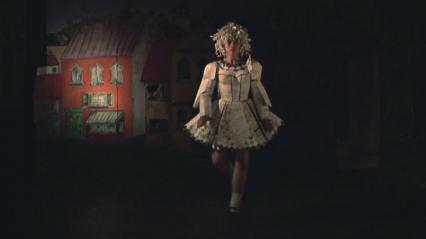
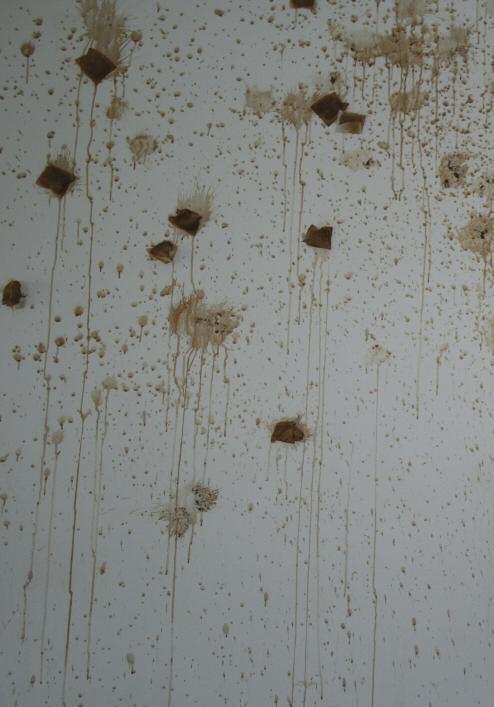


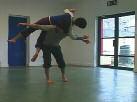
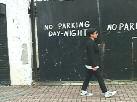



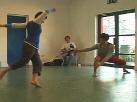










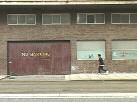





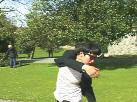
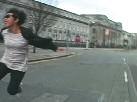
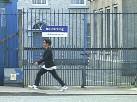
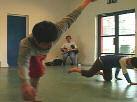




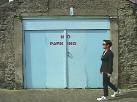








A r t i st s i n Re s i d e n c e
Ar tists’ experiences of studio 468’s Ar tist in Residence programme
Nevan Lahar t 06 12 2003
I had just finished my MA at NCAD, which took a bit out of me I was knackered and found it difficult to truly get going I wanted to use my time in the studio to re gig my work practice and experiment with different approaches I was a bit unsatisfied with the work I produced, but it lay the ground work for what I am presently at, which in this game is often the way it goes.
I found it hard to get many takers for the ar t as a lot of the clients in the Rialto Drug Team were on full time courses where they already did ar t. Others were struggling to cope with ver y difficult situations and getting it together to go to ar t could be tricky The takers were few This does not in any way mean it was unproductive I listened a lot and was informed by people with firsthand experience about something which I believe is neglected but of paramount impor tance to societ y This experience will work its way into my work, if not directly then by something resembling the attitude of those I engaged with NL 12 2003
Chris Reid 09.2004 02.2005
My expectations were that I should be able to set up a situation whereby the group would be able to have a large input into the direction of the process and the finished ar t work Upon confronting the realit y of ageing and the routine of the Rialto Day Care Centre I found that I had expected too much There were inconsistencies in attendance due to illness or medical check ups and age related disabilities of the group included various degrees of blindness, deafness and dementia, some of which made communication difficult The necessit y for almost constant staff super vision meant that my meetings with the group were constantly being interrupted In response to this realit y I changed my medium to video
Using video enabled me to include all the members of the group in some way, as well as to engage directly with the routines, activities and spaces of the day care centre itself while also recording the memories and relationships that the group had of the wider cit y. Though I had to retain most of the editorial control, clients and staff can still contribute to and influence the finished piece.
I would say that working in St Andrew’s has made me more aware of the need for a fluid, sensitive and flexible approach to working with people in their specific context If difficulties occur they can become par t of the solution that leads to the final piece rather than a hindrance CR 05 2005
Nevan Lahar t studied at Limerick School of Ar t and Design and the National College of Ar t and Design, Dublin He worked with the Rialto Community Drug Team while resident in studio 468 in 2003 He subsequently completed a residency at the Irish Museum of Modern Ar t and at Solas Nua, Washington DC Group exhibitions include the 2004 and 2005 Eurojet Futures exhibitions at the Royal Hibernian Academy, Eigse, Carlow, 2006, and ev+a 2006, Limerick He has held solo exhibitions at the Butler Galler y, Kilkenny, in 2007 and at the Royal Hibernian Academy in 2010 See: www nevanlahar t com
48 49
Fiona Whelan 12 2003 05 2004 / 11 2005 04 2006
In 2004, I under took a residency in studio 468, entering into a collaborative process with Rialto Youth Project Prior to the residency I had an individual practice as a painter and also worked in more educational and facilitative roles with young people studio 468 offered me the oppor tunit y to bring those t wo practices together Being based in the studio full time allowed me to work with the youth project in an organic way and I could be present to people and place as an ar tist. In addition to the public ar t works that resulted from this process, the relationships that formed during this initial experience were to become the bedrock to a long term dialogical practice in Rialto. Over 5 years, I have built my ar t practice within this context, working alongside a team of Youth Workers, developing a collaborative practice that transcends any of our individual disciplines and discourses and promotes the added value of a cross sectoral approach The relationships and learning that arose from the first few years of this practice, laid the foundation for the formation of a new interdisciplinar y group in 2008 called What’s the Stor y? Collective This group was set up as an attempt to push the boundaries of engagement within collaborative practice bet ween ar tists and young people and the organisations with which they connect What’s the Stor y? Collective is made up of six young adults, t wo Youth Workers and myself, as Ar tist, who have been developing a critical practice through conversation, workshops and creative interactions, all committed to interrogating and understanding the power relationships at play both within the collective and within our ever yday lives as individuals. Having always struggled to find an appropriate form in which to create moments where the public could encounter this work, so often producing objects that felt ver y removed from the par ticular qualit y and genealogy of the ongoing dialogue, November 2008 saw an interesting turning point Anonymous; reading, narrative and memor y was a live par ticipator y reading event that marked the first public engagement from this Collective We constructed an intimate event with an invited audience of 60, to par ticipate in both reading and responding to a selection of the aforementioned personal stories The learning from this event led to the planning of a number of other works such as a second reading event in IMMA with members of An Garda Siochana and the development of a mobile structure called Section8 Our intention is to initiate meaningful creative experiences in the public domain in response to the stories, in a way that opens dialogue and invites response FW 11 2009
Chris Reid was resident at St Andrew’s in 2004, where he developed a documentation and stor ytelling process with elderly people in the Rialto Day Care Centre which led to the production of a DVD. He subsequently under took a residency at the Irish Museum of Modern Ar t in 2004 and has exhibited in many group shows including eva+1 2007 in Limerick and Iontas 07 in Sligo. In 2008 he completed a permanent public ar t work in Nicholas Street, Ross Road, Bride Street and Bride Road in Dublin, commissioned under the Percent for Ar t scheme. As a par t of this scheme Chris is currently producing a book based on recorded oral narratives of residents living on the aforementioned streets. The par ticipator y ar ts organisation Create will publish and launch this work in June 2010. Chris is also producing a film that was commissioned by Ballyfermot Drugs Task Force. See: www.chrisreidar tist.com
Fiona Whelan studied Fine Ar t at the National College of Ar t and Design, Dublin, and completed a Post Graduate Diploma in Community Ar ts Education there in 2003. Fiona later completed the MA Ar t in Public at the University of Ulster, Belfast. She under took her first residency in studio 468 in 2004 during which time she began collaborating with Rialto Youth Project. Following this initial phase of work, Fiona developed a long term collaborative relationship with Rialto Youth Project, suppor ted by Common Ground, working alongside youth workers and young people to develop and produce work. Since 2007 they have focused on a three year project entitled What’s the Stor y? See: www.section8.ie
Kennedy + Jessica Kennedy 07 10.2005
The aim was an oppor tunit y to work on our next project which was performed in the Dublin Fringe Festival. We also worked in the Rialto/Fatima areas, facilitating dance workshops which we thoroughly enjoyed The award helped our collaboration abilities, not just with each other but with other ar tists also involved in the Rialto project and this opened up a dialogue with visual ar tists, musicians and outside dance mentors
studio 468 was in a communit y that we would have not have become familiar with if we hadn't been given the award, especially in terms of teaching and working with young people and other ar tists For us even our rehearsal process was changed because of the studio space, which we found interesting We liked how the space felt ver y much our own MK + JK, 10 2005
Megan Kennedy + Jessica Kennedy were resident in studio 468 from July to October 2005, during which time they worked with the Ferrini Youth Club and Fatima Homework Club During their studio 468 residency they developed Circus Freak. The dancers co founded junk ensemble in 2004, which is committed to creating works of brave and innovative dance theatre. Other junk ensemble works include Drinking Dust (Winner Culture Ireland Touring Award 2008), The Rain Party (Winner Excellence and Innovation Award 2007), and Watch Her Disappear (2004), which have toured nationally and internationally, the upcoming Five Ways to Drown (premiering in Dublin Dance Festival, May 2010). junk ensemble has been commissioned to make a new work in Aix en Provence, France, in July 2010. junk ensemble is par t of Project Catalyst at Project Ar ts Centre. See: www.junkensemble.com
Jane Hughes 07 10 2005
I shared the space of studio 468 with t wo dancers Megan and Jessica Kennedy from August to October 2005 I recall a great sense of freedom the moment I was handed the bunch of keys to the studio The knowledge that I could come and go at any time of the day or night to practise the cello gave a sense of renewed energy to my practice rituals Living in a house with three flat mates meant that I usually planned my practice sessions around their schedules As a professional freelance musician, the possibility of having a free, designated practice space in Dublin city during the Celtic Tiger era was not the likeliest of events. And yet, thanks to the vision of Common Ground, DCC Arts Office and Rialto Development Association, this is exactly what happened.
studio 468 overlooks an enclosed garden square. During practice sessions I could be seen, and probably heard across the square by the ladies and gentlemen attending the Rialto Day Care Centre As par t of my studio residency, I was asked to identify a communit y group in the Rialto area with whom I would engage during the three month period The Day Care Centre was the first group to catch my eye, and therefore I performed for them with violinist Dara Daly who lived nearby I have returned to the Rialto Day Care Centre on many occasions since my residency, as a performer and workshop facilitator on behalf of the DCC Ar ts Office and the National Concer t Hall
During my time in Rialto, I met a group of Congolese musicians through the Rainbow Neighbourhood Project We arranged a jamming session to take place at studio 468 The session began with songs and rhythms from The Congo, and continued with some Irish ballads and original music by Rialto Youth Project worker Cian O’Melia (on guitar and vocals) and myself on cello. Cian and I collaborated again later in the year when we performed at a multi cultural evening in Inchicore.
studio 468 is a unique and valuable resource for Dublin 8 It provides and promotes par ticipation and access to the ar ts for the local communit y and offers ar tists a suppor tive environment in which they can express themselves and develop new skills The ongoing provision, maintenance and occupancy of this studio are testament to its continued success JH 02 2010
50
51
Megan
Kang-Hyun Ahn 05 10 2006
The residency gave me the chance to realise what I lack and need to develop in my work as an ar tist I learned a lot from seeing how others work and handle ever yday events at St Andrew’s Communit y Centre I was really impressed by the seminars, talks, and conferences as I could really see how ar t can change our lives and our environment Before my residency, I had experienced communit y based work only as an assistant in shor t term projects with primar y school students At studio 468, I soon realised that I was not experienced enough to establish ‘intimate’ relations with Centre members, who had tight schedules of their own, in such a shor t timeframe. So I tried to reach out to more random neighbours beyond the Centre, expanding my view to a broader communit y. This led to some interesting work, I think, but somehow I feel regretful about some oppor tunities within the Centre that I may have missed The feelings of disconnection and ‘outsiderness,’ as well as the limitation in time, were also obstacles during my time in studio 468
One of the wonderful things about my residency was that I was introduced to ever y single person at the Centre, even if meeting for a ver y brief moment, and I was invited to attend ever y single meeting I honestly felt that I was living there At the end of the summer festival ‘Bur y My Hear t’ in Fatima Mansions that I took par t in, I cried my hear t out I mostly worked on my own with suppor t from others It was great that there was always someone to go to for help My residency resulted in three works: a six minute video piece ‘Do Focail, Mo Capall’, a series of thir teen text collages ‘Your words, My lines’ and an experimental project called ‘Hello to all my new neighbours’. These would not have been possible without the suppor t of residents in the Rialto area. I returned home at the end of my residency with a renewed desire to contribute to the development of communit y based ar t in Korea KHA 03 2009
Seoidín O’Sullivan 11 2006 07 2007
‘Ar t projects and spaces can become free zones for making projects happen Ar tists have tactically used these periods to initiate ‘ new thinking’ or to put something for ward what would not have originally been seen as acceptable, possibly to risky It’s amazing what can be passed through or made to happen when you call it ar t.’1
The SCR Communit y Garden Project, Dolphin’s Barn
My residency at studio 468 began in November 2006. I moved into the ar tist studio situated in St Andrew’s Communit y Centre and while there confronted my ideas on ar t, par ticipation, activism and ownership
I was par t of the initial group of activists that set up Dublin’s first communit y garden on the canal in Dolphin’s Barn in 2005 This was the first time that I grew my own
Cellist Jane Hughes studied at DIT Conser vator y of Music, Dublin and at the Royal Scottish Academy of Music & Drama in Glasgow. As a freelance musician she has performed with the RTÉ Concer t Orchestra, RTÉ National Symphony Orchestra, The Irish Film Orchestra, Opera Theatre Company and Opera Nor th. She was resident in studio 468 from July to October 2005 during which time she worked with the Rialto Day Care Centre, local singer song writers and Congolese musicians. This culminated in a performance at an intercultural concert at Áras Mhuire Hall in Inchicore organised by the Canal Intercultural Community Centre.
Kang Hyun Ahn is from Korea and studied sculpture at Seoul National University before completing a Master of Fine Ar t at The Slade School of Fine Ar t, London. She was included in the prestigious Bloomberg New Contemporaries exhibition in 2004. While resident at studio 468 in 2006 she worked with the Rialto Day Care Centre, Rialto Youth Project, and individuals in the Fatima area. She exhibited her work from Dublin in Korean Young Artists 2006 at the National Museum of Contemporar y Ar t, Korea. She now lives and works in Chicago and continues to exhibit internationally. See: www.ahnkanghyun.com
South Circular Road Community Garden
Top to bottom: The gardeners; studio 468; Seoidín O’Sullivan in the garden
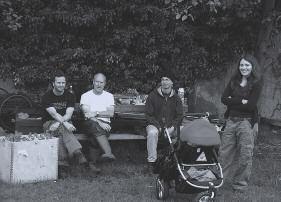


52 53
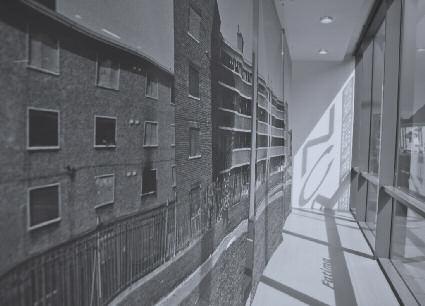
 Top and bottom: Vagabond Reviews and Fatima Groups United exhibition, Fatima A Cultural Archaeology, at NCAD Galler y, May 2009
Top and bottom: Vagabond Reviews and Fatima Groups United exhibition, Fatima A Cultural Archaeology, at NCAD Galler y, May 2009
food. That year I learnt so much about the environment, food, gardening, collective organising, the creation of a positive space, trust and about how impor tant communit y gardens are for our contemporar y cities. There was no teacher; it was non hierarchical, merely learning by doing and skill sharing
Communit y Gardens are collectively organised sites concerned with food production in a cit y The communit y garden is about relationships with neighbours, with land use, with food and with nature It is a space where skill sharing and learning can take place
This squatted garden acted as a locus and knowledge sharing point for a number of activists and people living within the communit y wanting to respond to the direction that Dublin’s development was heading in
During my residency in studio 468 the gardeners were evicted from the site on the canal I called a meeting in studio 468 and through the ar t residency managed to get permission from a local landowner to use a wasteland site for free. The studio in St Andrew’s with its glass fronted doors acted as an incubation space for vegetable and fruit seeds in April 2007.
The site that we used and are still using to this day is on loan from St Salvage They kindly gave us permission to use the site up till the planning application for apar tment blocks had been approved and building on the site can go ahead Even though we knew the site had planning permission on it, we decided to go ahead with the project anyway We could at least create a protot ype project that other communit y groups could be inspired by and Dublin cit y council could see how they work and possibly suppor t them at a future date 2 With the economic down turn we may have the site for a good few years to come
The residency at studio 468 gave me the leverage to accelerate the next phase of the communit y garden project I was in the enviable position of being able to use my connections and links with the St Andrew’s communit y centre to give the project validit y. The studio team had outlined that we did not have to come up with a finished product but that the space was an oppor tunit y to work with a communit y group of our choice. Their ethos provided me with the time and space to experiment and push my ar t practice
I have changed my hat a lot over the course of the project I am an environmental activist, a local resident, an ar tist, a gardener and more recently a DIT lecturer in the fine ar t and design depar tment, with my students using the garden as a learning space on Ar t and Sustainabilit y I put on the hat that fits at various times in order to keep the communit y garden project moving for ward
The project only works through a collective effor t It is all run on a voluntar y capacit y It has been inspiring over the last three years to see and meet the many dedicated individuals who have given time to the project all adding their creativit y, skills, input and aspirations It’s a small project with big ideas on the future of our cities
‘ ... In practice, the world of contemporar y ar t has proved to be the most flexible environment for diverse projects, being a free zone of experimentation within the societ y at large the projects are labeled ar t only for strategic reasons the strategy works as long as the concepts of ar t do not come to dominate the discourse The same applies to the individuals working in the group: you call yourself ar tist, just because it is institutionally convenient, because the ver y concept of ar tist is obscure ’3
SO’S, 04 2010
54
55
1 Excerpt from IC 98 website: www socialtoolbox com
2 In 2010 through the environmental forum we have published a booklet on communit y gardens for Dublin
3 Excerpt from IC 98 website: www socialtoolbox com
Seoidín O’Sullivan was resident at studio 468 from November 2006 to July 2007 where she developed The South Circular Road Community Food Garden Project. She grew up in Durban, South Africa where she completed a degree in Fine Ar t; she later completed a Masters in Fine Ar t at NCAD, Dublin. In 2008 she par ticipated in a two month residency at The Land Foundation in Thailand. Her ar t project TACTIC, in collaboration with South African ar tist Ralph Borland, received an Ar ts Council Project New Work Award in 2008 and a six month incubation space award at The L AB. Her collaborative film and research project TRESPASS, with Aoife Desmond, was awarded Ar ts Council funding in 2007 and was exhibited in The L AB in March and April of 2009 She recently received an Artist in the Community Project award to develop a project with St Margaret's Traveller Centre in Ballymun She currently lectures at Dublin Institute of Technology
Anne Maree Barr y 09 2007 05 2008
The aim of the Rialto Twirler project was to collaborate with a contemporar y Irish subculture group whilst expanding my practice to professional filmmaking I embarked on a method of looking for possibilities beyond my normal processes and contexts that were previously involved in the production of my work.
On residency at studio 468, in association with Common Ground I began to examine my practice and what I wanted to achieve My initial field research led me to accompanying the Rialto Twirlers to competitions at the Tallaght Basketball Arena
After establishing a relationship with the group I felt that they were wor th a bigger stor y than one of my experimental shor t films With confidence resulting from a New Work Award from the Ar ts Council, I began to develop the project and push my practice professionally I approached Nicky Gogan, Director of the Darklight Film Festival and co founder of Still Films, and she agreed to produce Rialto Twirlers
In December 2008, I organised a workshop with Mark Br yan, a Cheer Music producer from Baltimore, USA with members of the Rialto Twirlers at the Dolphin House Computer Digital Project Mark Br yan has remixed music on the successful cheerleading film Bring It On (Peyton Reed, 2000). Collectively we remixed a Robin S track for the Rialto Twirlers majorette troop to perform to at competitions.
In July 2009, the Rialto Twirlers film shoot took place at the former Eason's Warehouse in Crumlin The film was officially selected for the 2010 Dublin International Film Festival A solo exhibition in the Lab, Foley Street, in May 2010 will contextualise and document the project and film AMB 04 2010
Terr y Blake 09 2007 05 2008
Working with young people in a communit y is both a challenging and rewarding experience. The initial priorit y of any ar tist is to build a good relationship with the people that they are working with and have an in depth understanding of the localit y and its histor y
The voice of young people is often dismissed, ignored or taken for granted Any ideas of collaboration with young people should come solely from them It is the ar tist’s role in collaboration with youth workers to nur ture and encourage these ideas It should be
Anne Maree Barr y attended the The Limerick School of Ar t and Design and The National College of Ar t and Design, Dublin. Her experimental shor t film, Covered Road, was the winner of the Best Irish Shor t award at the at the 2006 Darklight Film Festival, Dublin While resident at studio 468 from September 2007 to June 2008 she began developing a film project with the Rialto Twirlers, a majorette group, for which she was awarded a grant from the Ar ts Council After leaving studio 468 she was awarded a project studio at Temple Bar Galler y and studios to fur ther develop the project The film, Rialto Twirlers, was shown at the 2010 Dublin International Film Festival
educational without ever being like school. Young people’s ideas are always fresh and vital whether they are aware of it or not. Their development in skills is rapid and over a small period of time this becomes apparent and vivid in the quality of their work. TB 04 2010
Terr y Blake studied at The Limerick School of Ar t and Design and The National College of Ar t and Design, Dublin, where he completed a Diploma in Community Ar ts Education. While resident at studio 468 from September 2007 to May 2008 he developed his film work with different groups including Rialto Youth Project. For three years Terr y also held a long term working relationship with St Michael’s Youth Project, and young men from the Youth Project. Pimp My Irish Banger was installed as par t of the St Michael’s Estate installation Tales from the Promised Land in November 2008 and invited to the inaugural exhibition at NCAD Galler y in Februar y 2009
Anne Marie McGrane 06 2008 01 2009
Anne Marie McGrane studied at The Dublin Institute of Technology and at The National College of Ar t and Design, where she completed a Diploma in Community Ar ts Education Before her residency at studio 468 she had worked as an ar ts facilitator with the Rialto Community Drugs Team, The Adelaide and Meath Hospital and the Base Youth Centre, Ballyfermot While resident at studio 468 from July to December 2008 she worked with the Rialto Community Drug Team.
Lisa Marie Johnson 06.2008 01.2009
I worked with immigrant and local women and mothers during my residency to create The Listening Projects The work produced during The Listening Projects was mostly video and text, but I also attended cour t with one of the mothers as a translator/performer With The Listening Projects I provided a suppor ting place, a place of conversation and of performance
During the residency I also worked with teenagers and children; changing the studio where they worked into a ‘social cinema’ with screenings of animation and film from Russia and Eastern Europe Alongside these collaborative works and screenings, I also used the residency as a space for wider discussion A Working Class Seminar saw ar tists and residents discussing working class in public practice
Collaborative work such as The Violence Couch also emerged out of this residency. My performance work also emerges out of a communit y based practice. Anonomom, 2007/08, Human Error, 2008, and Parameters of the Gothic, 2009, were all performances that emerged from, and merge with, my communit y practice Much of my research during the Masters program has involved supplicancy around class, marginalisation, gender and identit y Most recently I organised and curated a lecture and garden par t y called A conversation with you ‘Winter is a woman, she unear ths, unfarms and bawls for her lost children’
• The Listening Projects involved Sinead, Tina, Fernanda and Gail I was par ticularly influenced in her choices by her work with one of the mothers
• Those par ticipating in A Working Class Seminar included Seamus Nolan, Dominic Thorpe, Sarah Tuck, Aislinn O’Donnell, Her v, poets Dave Lordan and PJ Brady, and Common Ground
• The Violence Couch was in collaboration with Dr Tina McVeigh, Ailbhe Smith and Frank Connolly. Anonomom was performed at Excursions festival, Limerick, and Live Zones, Holland.
• Human Error was performed at A Foundation, Liverpool Biennial
• Parameters of the Gothic was a collaboration with queer activists and American poet Raven at Lighthouse Cinema, Dublin, and Shunt Galler y, London
56 57
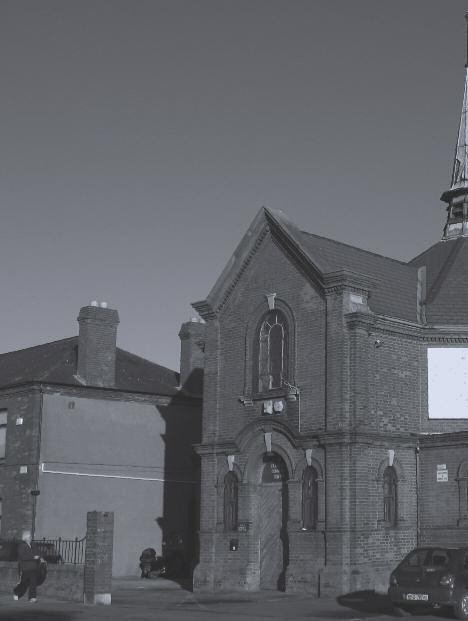 St Andrew’s Communit y Centre, 468 South Circular Road, Rialto, Dublin 8
St Andrew’s Communit y Centre, 468 South Circular Road, Rialto, Dublin 8
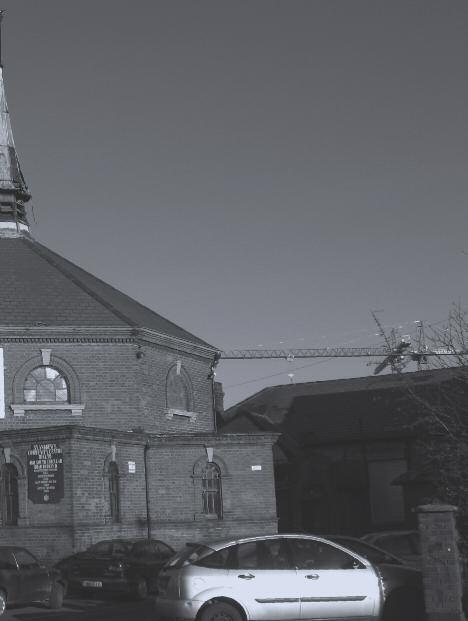
• A conversation with you included Jenny Haughton, Vivienne Dick, Amanda Coogan, Áine Philips, Mar y Ruth Walsh, Sandra Johnston, Christine Buckley, Katerina from the food co op and Clare Bonas (singer/songwriter).
LMJ 04 2010
Lisa Marie Johnson studied Speech and Drama Theatre at Dublin Institute of Technology and completed a course for facilitators in ar t and conflict at the Cross Border Centre, Dundalk. She is currently completing a Masters of fine ar t at NCAD. She is a freelance practitioner of Theatre of the Oppressed, a form of theatre developed by Brazilian director Augusto Boal. Prior to the studio 468 residency Lisa Marie had performed at Tulca ar ts festival, Galway, and Eigse, Carlow, 2006, and ev+a 2006, Limerick. With Seamus Nolan she co curated the events programme at Hotel Ballymun in 2007 During her residency at studio 468 from July 2008 to Januar y 2009 she worked with a range of groups and individuals in the Rialto area
Vagabond
Reviews
+ Fatima Groups United 01 09 2009
Since 2008 Vagabond Reviews and Fatima Groups United have been working together on a collaborative research initiative called Cultural Review Focusing on the rich histor y of ar ts and cultural practice in Fatima/Rialto, Cultural Review is organised into three strands of inquir y loosely corresponding to preoccupations with the past, Cultural Archaeology; the present, Cultural Audit; and the future, Cultural Anticipations. In Februar y 2009 Vagabond Reviews began a residency in par tnership with Fatima Groups United at studio 468, where we initiated the first strand of inquiry, Cultural Archaeology
Cultural Archaeology at studio
468
We began by defining the Cultural Archaeology as an archive (documents, photographs and films), a collection of objects and a series of conversations with communit y and youth leaders, representative residents groups, ar tists and communit y activists studio 468 became an open site of recollection, a space for reviewing and (re)presenting narrative seams on a communit y histor y from multiple perspectives Our inquir y began to take the form of a timeline sketch around the studio walls, reflecting early memories of Fatima Mansions following the move from inner cit y tenement housing in 1949. Spanning the decades, our inquir y explored more recent times where the arc of ar ts and cultural practice has been brought into play by the communit y and its leadership in the struggle to secure meaningful agency within the urban regeneration process By putting these narrative traces together we hoped to capture and display something of the richness of the stor y of Fatima through the lens of its ar ts and cultural life
Cultural Archaeology at NCAD Galler y
In May 2009 the Cultural Archaeology project was in residency at the National College of Ar t and Design Galler y where it operated as a continuation of the open site of inquir y established at studio 468 While first findings were on display, the residency at the NCAD Galler y continued to develop and extend the Cultural Archaeology research process We also used the NCAD residency as an oppor tunit y to focus on the question of pedagogy and urban regeneration through structured and informal dialogue with a range of perspectives including ar tists, students, architects, youth and communit y development workers and activists, writers and academics.
Cultural Archaeology at the F2 Centre
Following the residency at NCAD we returned to studio 468 to develop the Archaeology to the point at which it could be installed within the newly opened F2 Centre, the flagship communit y building of the newly regenerated Fatima Mansions Currently on display at the F2 Centre, the Cultural Archaeology Timeline Wall ser ves as a springboard for a longer term oral histor y project and communit y based archive
In Summar y
Our residency at studio 468 gave us an oppor tunit y to establish a dedicated presence in Rialto during the engagement and production phase of the Cultural Review. In addition, the studio became a hub for ar tists and local ar ts based initiatives including workshops with children from the Fatima and Dolphin Homework Clubs and a Drawing Group At studio 468 we were able to create an open, par ticipative and social presence for making, displaying and reflecting along a number of lines of inquir y with a number of different communit y and cultural practitioners Through that process we hope the first steps have been taken towards securing and building a communit y memor y at a key point of transition as Fatima moves beyond infrastructural transformation VR + FGU 02 2010
ar t inter
Jeong Hyun Kim + Dong Myoung Lee 11 2009 04 2010
For six months, Dong Myoung and I could really have a creative time as a breathing body in Ireland studio 468 in St Andrew’s Communit y Centre is a great place We could see a beautiful garden and sky all the time through the studio windows This atmos phere created by the surroundings gave us open eyes and bodies so we could think and dance alike The activities of our residency comprised body movement research including contact improvisation dance, filming and exchange with local people
This residency has given us relaxation to enjoy the basic originalit y of the body itself It’s a kind of turning point for me. During the residency there is no pressure for me to make innovative choreographies and create something new! I have been given time and space for thinking and researching what movement means for me, which I really needed
We have been able to do improvisation work with Mar tin Nolan, the Uilleann piper What a treasured experience! This collaboration with real Irish ar t encouraged nonverbal communication and exchange through music and dance I was excited to perform with an Uilleann piper, because I felt this pipe is a symbolic one from mythology, not a normal musical instrument We tried to find an interesting connection with sound and movement through improvisation practice and discussion It was meeting with a vivid Irish tradition!
Filming environmental dance was also so encouraging for us As strangers, we could have so much curiosit y which was then transformed into our expressions. In one film a black suited woman went around Dublin. She’s a total stranger. The appearance of the stranger could make the real things clear, different and fun. I hope this film project could be expanded to other cities.
We held dance workshops for staff from The Rialto Communit y Drug Team and the children of Generation Text It was an amazing experience The drug team adult workshop was a special time Ann and Mar y were great dancers with passion In fact, I’ve been afraid of conducting children’s workshops for a long time but this time with
60 61
Established by Ailbhe Murphy and Ciaran Smyth in 2007, Vagabond Reviews is an interdisciplinar y platform committed to developing creative and collaborative models of knowledge production through a combination of
ventions, research practice and critical analysis Major projects to date include Open Space research for Dublin City Council and Cultural Review with Fatima Groups United.
Fatima Groups United (FGU) is the elected, representative body of residents and community organisations operating within the community formerly known as Fatima Mansions, Rialto in the southwest inner city of Dublin. Over the past decade FGU has pioneered a radical new approach to the physical, social, economic and cultural regeneration of the area.
Generation Text I could step for ward to children. It was significant and magical experience with body language. I still remember their rosy cheeked faces while dancing. This memor y will last a long time with us.
During the residency, Siobhán, Kieran, Chris and Logan helped us with many things in all sincerit y Through them, we can understand more about Irish culture and the regional character of Dublin, especially about Rialto And most of all we got love from them like a family Thank you so much JHK + DML 04 2010
Dancers Jeong Hyun Kim and Dong Myoung Lee are both members of the improvisation group, Improad Badac, based in Seoul Jeong Hyun Kim studied choreography at the Korean National University of Ar ts having previously studied film and French literature She has choreographed dance pieces and works for theatre, film and also for public spaces Dong Myoung Lee studied dance at Yong in University He has performed both dance and musical performances While in Dublin from November 2009 to April 2010 the dancers held workshops with staff from the Rialto Community Drug Project and with children from Generation Text Their residency culminated in a dance showcase at St Andrew’s Community Centre
Jennie Moran 05.2010 01.2011
Jennie Moran began her residency at studio 468 in April 2010, just prior to the launch of this publication; her residency continues until Januar y 2011 during which time she will pursue her work in which she seeks to create oppor tunities for hospitality. She studied sculpture at the National College of Ar t and Design and has continued her learning though residencies in Iceland, Italy, and Argentina. She was Ar tist in Residence at Airfield, Dublin, in 2008, resulting in the solo exhibition, A Space That Gives You The Possibility To Think Something Else. More recently she was Ar tist in Residence at the Killrudder y Film Festival, Wicklow. Her projects have been facilitated by a Dublin City Council Ar t Bursar y in 2006, an Ar ts Council Project Award in 2007 and an Ar ts Council Ar tist in the Community Award in 2009. She has worked with Kildare County Council, Leitrim Sculpture Centre, Galway University Hospital Ar ts Trust, and the curators/cultural consultants Marjetica Potrc, Sally Timmons and Sarah Searson She is par t of the collaborative projects Hope Inherent (see www hopeinherent com) and Poetic Geographies (see www poeticgeographies com)
Contributors
John Bissett was born in Dolphin House, Rialto He ser ved an apprenticeship as a fitter in the Irish Glass Bottle Company in the early 1980s John spent some years in Australia and Canada in the late 1980s before returning to Ireland where he then attended the National Universit y of Ireland Maynooth graduating with a degree in Sociology and English He continued his studies at Universit y College Dublin and was awarded a Masters and Ph D in Sociology on the same occasion in 2001 John currently works as a Communit y Worker for the Canal Communities Local Drugs Task Force in Dublin He has been a member of the St Michael's Estate Communit y Regeneration Team since Februar y 2001 He is the author of Regeneration: Public Good or Private Profit?, published by New Island as par t of the TASC series in 2008
Jamie Hendrick is 19 years old and from Dolphin House, Rialto, Dublin 8 He has been a member of Rialto Youth Project since 1998 Jamie has continued to volunteer in Rialto Youth Project and four years ago Jamie completed FETAC Junior Leadership Training Jamie plays a key role in the Hemispheres Project; an EU funded initiative that brings young people from the Nor thern and Southern Hemispheres together in Paris to discuss and explore world issues, global economics, the environment and pover t y In November 2009 the What s the Stor y? collective was invited to present Twelve Anonymous Lithuanian Stories as par t of the visual ar ts programme of the NEU NOW Festival in Vilnius, Lithuania The collective will be exhibiting in The Lab, Dublin, in late 2010 Please see www section8 ie and www neunow eu for more information on the What’s the Stor y? collective
Siobhán Geoghegan is Director of Artistic Programme in Common Ground and has been working there since its establishment in 1999 As well as the development of studio 468, Siobhán has worked with a variet y of local communit y based projects and ar tists on a wide variet y of ar tistic programmes Based in Inchicore, Dublin, Common Ground is an ar ts development organisation that believes that the ar ts can play a central role in transforming and empowering communities It is committed to bringing professional ar tists and communities together on ' common ground' In 1998 Siobhán was awarded H Dip in Ar ts Adminstration by UCD She previously worked for ten years as a teacher of Ar t and Design in Dublin and overseas following her graduation from Crawford School of Ar t and Design in 1988 Siobhán is currently completing an MA in Ar t in the Contemporar y World at NCAD on a par t time basis
Ailbhe Murphy is a visual ar tist living and working in Dublin whose practice has been based primarily within the communit y development sector Past collaborative projects include Unspoken Truths, 1991 to 1996, with IMMA, the LYCS and the Family Resource Centre, St Michael s Estate, Once is Too Much, 1997 to 1998, with IMMA and the Family Resource Centre, St Michael’s Estate and Tower Songs, 2003 to 2006, with Cit yAr ts, Fatima Groups United and the Rialto Youth Project From 2002 to 2004 she was Liaison Ar tist for Breaking Ground, the per cent for ar t programme in Ballymun Co founder of Vagabond Reviews, 2007, an interdisciplinar y ar ts and research platform, recent projects include commissioned international research for Dublin Cit y Council on Ar t in Urban and Suburban Open Space and the Cultural Review with Fatima Groups United Currently completing her doctoral studies at Interface (UU) Belfast, her research interests focus on critical co ordinates for collaborative ar ts practice in contexts of urban regeneration See: www vagabondreviews ie


 Image from Kang Hyun Ahn, Do Focail, Mo Capall (Your Words, My Horse), video documentation of performance, 2006
Image from Kang Hyun Ahn, Do Focail, Mo Capall (Your Words, My Horse), video documentation of performance, 2006











 Right: junk ensemble (Megan Kennedy and Jessica Kennedy), Circus Freak
Par ticipants in an invited ar tists discus sion event, Februar y 2008 Left to right: Chris Reid, Dennis McNult y, Seoidín O Sullivan, Anne Maree Barr y, Terr y Blake, Lisa Marie Johnson
Right: junk ensemble (Megan Kennedy and Jessica Kennedy), Circus Freak
Par ticipants in an invited ar tists discus sion event, Februar y 2008 Left to right: Chris Reid, Dennis McNult y, Seoidín O Sullivan, Anne Maree Barr y, Terr y Blake, Lisa Marie Johnson
 Nevan Lahar t speaking to students from NCAD’s Postgraduate Diploma in Communit y Ar ts course
Nevan Lahar t speaking to students from NCAD’s Postgraduate Diploma in Communit y Ar ts course



















































 Top and bottom: Vagabond Reviews and Fatima Groups United exhibition, Fatima A Cultural Archaeology, at NCAD Galler y, May 2009
Top and bottom: Vagabond Reviews and Fatima Groups United exhibition, Fatima A Cultural Archaeology, at NCAD Galler y, May 2009
 St Andrew’s Communit y Centre, 468 South Circular Road, Rialto, Dublin 8
St Andrew’s Communit y Centre, 468 South Circular Road, Rialto, Dublin 8
